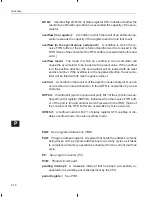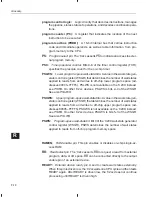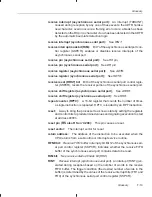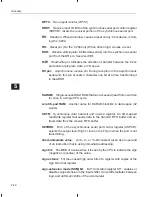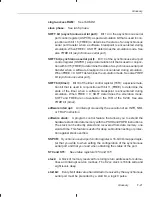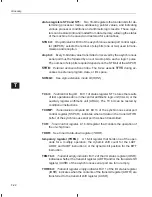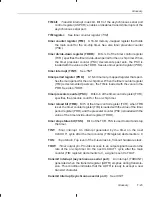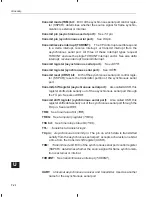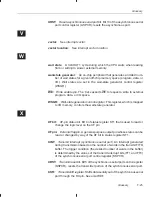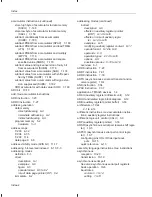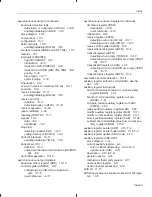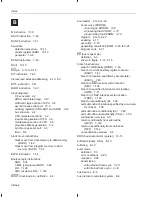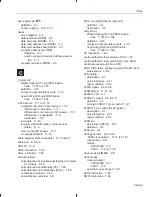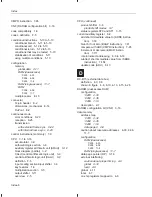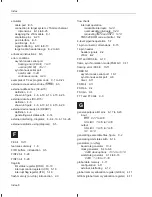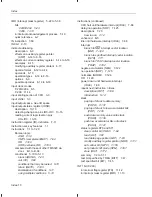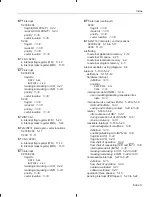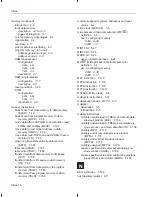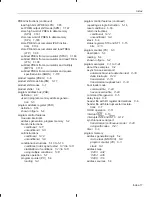
Index
Index-3
asynchronous serial port
(continued)
baud-rate detection logic
detecting A or a character (ADC bit)
10-10
enabling/disabling (CAD bit)
10-8
block diagram
10-3
components
10-3
configuration
10-7
delta interrupts
10-17
enabling/disabling (DIM bit)
10-8
emulation modes (FREE and SOFT bits)
10-7
features
10-1
interrupts (TXRXINTs)
flag bit (TXRXINT)
5-21
introduction
10-5
mask bit in IMR (TXRXINT)
5-23
mask bits in ASPCR (DIM, TIM, RIM)
10-8
priority
5-16
three types
10-17
vector location
5-16
introduction
2-12
overrun in receiver, detecting (OE bit)
10-11
overview
10-2
receive interrupts
10-17
enabling/disabling (RIM bit)
10-8
receive pin (RX)
definition
10-4
detecting break on (BI bit)
10-10
receiver operation
10-20
reset conditions
5-34
resetting (URST bit)
10-7
signals
10-3
data
10-3
handshake
10-3
stop bit(s)
detecting invalid (FE bit)
10-11
setting number of (STB bit)
10-8
transmit interrupts
10-17
enabling/disabling (TIM bit)
10-8
transmit pin (TX)
definition
10-4
output level between transmissions (SETBRK
bit)
10-8
transmitter operation
10-19
asynchronous serial port registers
baud-rate divisor register (BRD)
10-13
control register (ASPCR)
10-7
configuring pins IO0–IO3 as inputs/out-
puts
10-15
quick reference
A-13
asynchronous serial port registers
(continued)
I/O status register (IOSR)
description
10-10
quick reference
A-13
introduction
10-4
receive register (ADTR)
detecting overrun in (OE bit)
10-11
detecting when empty (DR bit)
10-11
receive shift register (ARSR)
10-5
receive/transmit register (ADTR)
10-4
transmit register (ADTR)
detecting when empty (THRE bit)
10-11
detecting when it and AXSR are empty (TEMT
bit)
10-10
transmit shift register (AXSR)
10-5
detecting when it and ADTR are empty (TEMT
bit)
10-10
transmit/receive register (ADTR)
10-4
automatic baud-rate detection
10-14
auxiliary register arithmetic unit (ARAU), descrip-
tion
3-12
auxiliary register instructions
add short immediate value to current auxiliary
register (ADRK)
7-33
branch if current auxiliary register not zero
(BANZ)
7-41
compare current auxiliary register with AR0
(CMPR)
7-65
load specified auxiliary register (LAR)
7-80
modify auxiliary register pointer (MAR)
7-111
modify current auxiliary register (MAR)
7-111
store specified auxiliary register (SAR)
7-152
subtract short immediate value from current aux-
iliary register (SBRK)
7-154
auxiliary register pointer (ARP)
3-16, F-2
auxiliary register pointer buffer (ARB)
3-16, F-2
auxiliary register update (ARU) code
6-13
auxiliary registers (AR0–AR7)
block diagram
3-12
current auxiliary register
6-9
role in indirect addressing
6-9 to 6-18
update code (ARU)
6-13
description
3-12 to 3-14
general uses for
3-14
instructions that modify content
6-17
next auxiliary register
6-11
used in indirect addressing
3-12
AVIS bit
11-17
AXSR (asynchronous serial port transmit shift regis-
ter)
10-5


